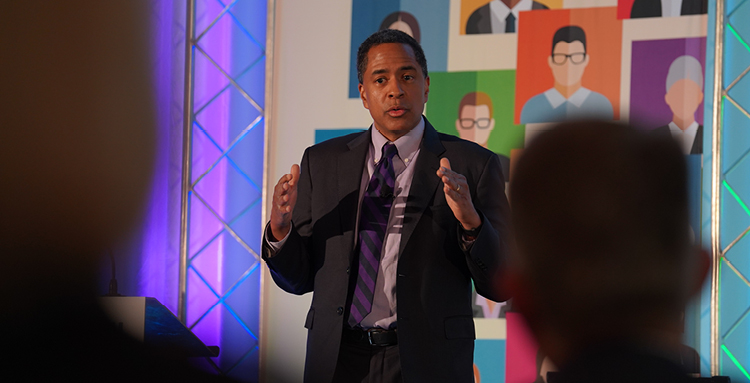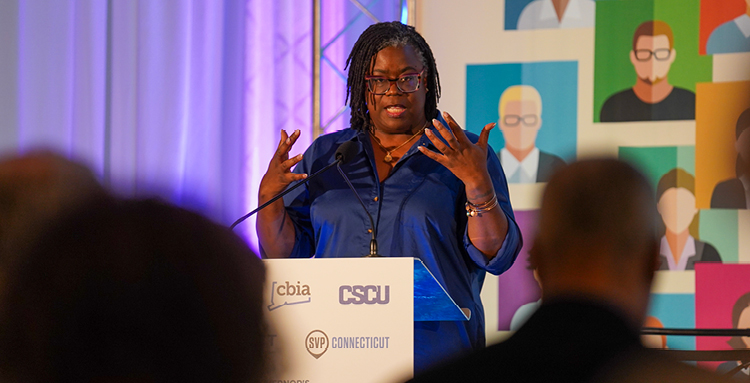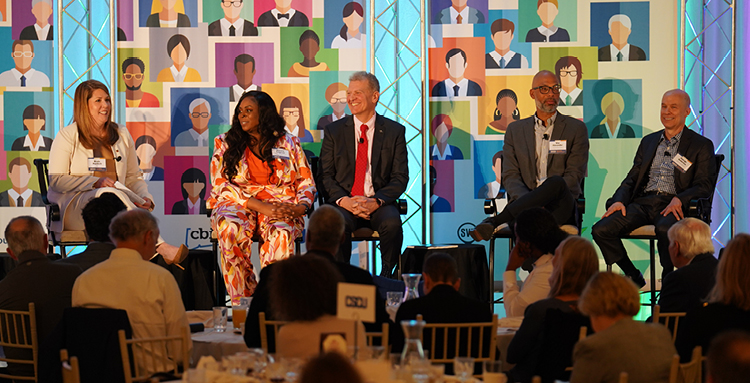Workforce Development: Breaking Down Silos, Realizing Opportunity

For the 430-plus business leaders, educators, community leaders, and policymakers at the April 21 Connecticut Workforce Summit, one common theme rang throughout the day.
“For me, today is all about realizing opportunity,” said CBIA president and CEO Chris DiPentima in his opening remarks.
“It’s about unlocking Connecticut’s incredible potential, working together to make sure that everyone in this state—regardless of who they are and where they come from—has a pathway to pursue the career of their choice.”
The conference—a collaboration between CBIA, the Connecticut Office of Workforce Strategy, Connecticut State Colleges and Universities, Governor’s Workforce Council, ReadyCT, and Social Venture Partners Connecticut—focused on leveraging public-private solutions to address the state’s worker shortage crisis.
Connecticut has 100,000 job openings—43% more than before the pandemic—with a labor pool that can only address 75% of those positions.
“The jobs are here,” DiPentima said. “The demand for Connecticut products and services has never been greater. What’s missing are the people to fill all those jobs.”
State Programs
The crisis is felt across all industries and driven by numerous factors, from structural challenges that pre-date the pandemic, to a large percentage of women leaving the labor force, an aging workforce, the high costs of living and doing business, and equity issues.
Kelli-Marie Vallieres, the state’s chief workforce officer, left the private sector in 2020 to direct implementation of the wide-ranging strategic plan developed by the business, public sector, education, and community leaders on the Governor’s Workforce Council.
This past January, OWS launched CareerConneCT, a $70M grant program funded through state pandemic relief dollars, to train 6,000 unemployed and underemployed individuals over the next three years.
The state also has 11 regional sector partnerships, led by business, in healthcare, information technology, bioscience, and manufacturing.

The federal Economic Development Authority awarded OWS $23.9 million, the largest award in the nation, to train and place over 2,000 people—particularly those from historically underserved communities—in high demand demand jobs.
CSCU is leading the $35 million Connecticut Health Horizons, in collaboration with the University of Connecticut and The Connecticut Conference of Independent Colleges, to build the nursing and social work pipeline.
OWS also launched Tech Talent Accelerator, a $1 million investment to help close the skills gap by expanding education for emerging and in-demand fields such as cybersecurity, virtual modeling, software development and digital analytics.
“There’s still a lot more work to be done,” said Vallieres. “It’s why we’re all here today, to take that next step together on how we can address some of these issues.”
Opening Doors
Mark Argosh, the executive director of Social Venture Partners Connecticut and chair of the Governor’s Workforce Council, told the crowd that “opening our eyes to the skilled talent that is all around us yet remains unseen and underutilized.”
“If we can unite around that vision, I believe we can move closer to realizing inclusive economic growth.”
Byron Auguste, the CEO and co-founder of the national nonprofit Opportunity@Work, told attendees that “the challenges we’re facing are solvable.”
“We cannot solve them in silos and they’re not going to solve themselves by accident.”
The nonprofit focuses on expanding access to career opportunities and connecting employers with the more than 70 million Americans who are skilled through alternative routes, or STARS.

Auguste said about 830,000 of Connecticut’s 1.7 million workers are STARS, and do not have bachelors degrees.
However, most new jobs require a bachelor’s degree, creating what Opportunity@Work calls the “paper ceiling.”
“When you talk about the war for talent, and you actually exclude over half of the workforce from your definition of talent, you’re going to lose it,” Auguste said.
“If you don’t have a STARs talent strategy, you really don’t have a talent strategy. You have half a talent strategy.”
He called on businesses to advertise for skills, hire people for skills, advance people for skills, and remove barriers to employment.
Building Partnerships
Breaking down those silos, removing barriers, and developing talent was also the focus of a panel moderated by CSCU president Terrence Cheng on building a partnership-driven ecosystem.
“Too much of what we have done has been based on a legacy that has exacerbated inequities,” Cheng said.
The panel featured Connecticut Department of Administrative Services commissioner Michelle Gillman, Pratt & Whitney VP of quality Robert Griffiths, Trinity Health SVP of human resources John Schwartz, and Greater New Haven Chamber of Commerce president and CEO Garrett Sheehan.
They discussed the public and private sector partnerships aimed at growing the workforce.

“We’re out turning over every stone looking at opportunities not only to improve, but to retain talent,” said Gilman, highlighting the agency’s partnerships with institutions and organizations that are doing skills-based work.
Griffiths spoke about Pratt & Whitney’s partnership with groups such as CBIA affiliate ReadyCT and the NAF Academy of Engineering that help provide career-based learning, especially for underserved students.
Schwartz added that Trinity developed a program to provide opportunities and accelerate entry for people who want to enter the healthcare field.
“There’s so many great partnerships that already exist out there, and we heard about some of them today, you know, a company working with a specific school or a specific university working with a couple of companies, but we can’t replicate individual relationships across the entire state,” said Sheehan.
“By working together and getting into these collaboratives, working in a regional or statewide approach by industry, we’re able to accomplish so much more and just find out so much more.”
Quality Jobs
A key piece of the conversation around workforce development centered on how to transform systems to focus on high quality jobs that serve the needs of workers, employers, and communities in equitable ways.
“You all are really working to build the scaffolding here to create a really strong economy and to make sure people can live up to their full potential,” said Tameshia Bridges Mansfield, VP of workforce and regional economies at the national nonprofit organization Jobs for the Future.
Bridges Mansfield talked about the need for investment in training and opportunities for high quality jobs.
She said a job’s quality isn’t just about compensation, but agency, and culture, and giving the employee a sense of belonging.

She also highlighted advancement as a key part of job quality.
“There’s work that has to be done from entry level to mid level to entire cultures of organizations that really can work to make a bad job better and to move people into better jobs,” she said.
“There is no organization that can look at that list and say, yeah, got it all covered. We are creating quality jobs for every single person in this organization.
“And it’s aspirational, and it is intentional. It’s about the commitment to working towards getting to all of those buckets and all of those elements are how you get there.”
Bridges Mansfield said another big part of designing solutions to the workforce crisis is to understand worker and community needs and to take a holistic approach to include areas like childcare, transportation, and housing.
Diversity, Equity, Inclusion
Bridges Mansfield stressed that a big part of the approach to improving job quality is to focus on equity.
“A lot of black and brown, and immigrants, and poor folks and women are clustered and stuck in really poor quality jobs,” she said.
Being intentional and deliberate about diversity, equity, and inclusion was the focus of a panel led by Nicole Murdoch, director of the DEI Committee for Eastern Massachusetts and Connecticut at CGI.
The panel included Alliance for Community Empowerment executive director Dr. Monette Ferguson, Wes Alexander, VP of workforce solutions at The Travelers Group, George Anderson, SVP and chief learning officer at Synchrony Financial, and Joseph Gianni, market president of the Hartford region at Bank of America.

“The pandemic helped to put a very bright light on the limited access to programs and resources to help folks evolve and be their best selves,” said Ferguson.
“It’s bigger than childcare, it’s bigger than transportation.
“It’s really about a system that was put in place to keep people from reaching their best potential.”
She said it will take an ongoing investment of resources and money to help to overcome those barriers to opportunity.
Intentional Investment
Business leaders on the panel spoke about the need to make sure that DEI doesn’t stop once a person has been hired into a company.
“It takes additional, intentional investment to create a culture that makes your place special,” said Alexander.
“It really drills down to belonging.
“We may have completely different experiences, but that connection creates belonging, and when we feel like we belong, we work better.”
The panel agreed that creating a sense of belonging and inclusion requires a commitment from everyone in an organization from the top down.
“We need to treat it like any other business priority,” said Anderson.
“Hope is not a DEI strategy. We had to figure out how to measure our progress.”
“We’ve got to solve these problems together, we can’t solve them as business, as government. We have to work together on these big societal issues” said Gianni.
“This kind of a forum that brings those things together, that’s how we can solve some of these issues.”
The summit concluded with a commitment from public agencies, businesses, educators, and community organizations to take specific actions to create a coordinated, coherent, and cohesive workforce development system.
“Collaboration and partnerships are the keys to solving our challenges and ensuring we provide the opportunities for all residents to pursue meaningful, rewarding lives and drive economic growth and prosperity,” DiPentima said.
The 2023 Connecticut Workforce Summit was a collaboration between CBIA, Connecticut Office of Workforce Strategy, Connecticut State Colleges and Universities, Governor’s Workforce Council, ReadyCT, and Social Venture Partners Connecticut and made possible through the generous support of CGI and KPMG with additional support from Wells Fargo.
RELATED
EXPLORE BY CATEGORY
Stay Connected with CBIA News Digests
The latest news and information delivered directly to your inbox.


